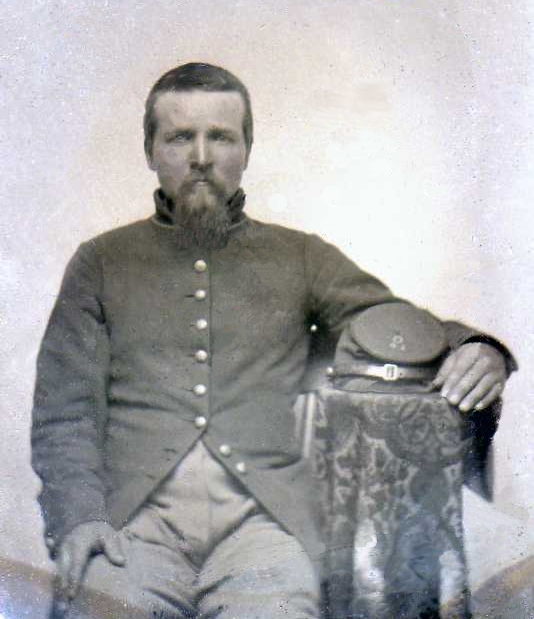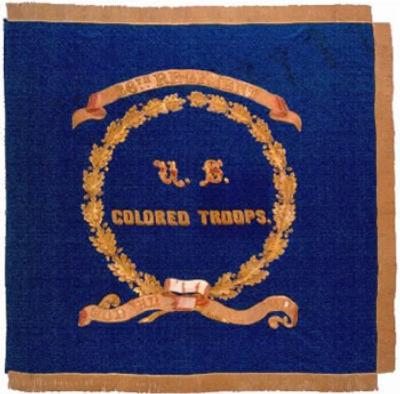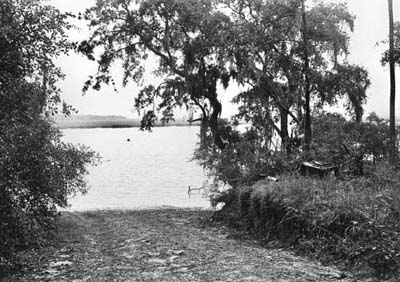The David Whitney Story
Part II – Chapter 3
Alonzo Whitney's Further Servicein Union-Controlled South Carolina

Captain Alonzo B. WhitneyCommanderCompany I, 26th USCT
Photo from Sprague-Whitney family collectionCourtesy of Patricia Holden Webster
Great-Great-Grandaughter ofEdwin and Maria Whitney Sprague
The 26th USCT
Alonzo Whitney followed his brother-in-law, Alpheus Cheney, out of the 10th Vermont Regiment also into an African-American unit, but not until March 4, 1864, when he was commissioned a Captain, commanding Company I of the 26th Infantry Regiment of the United States Colored Troops. The 26th USCT was organized at Riker's Island in New York Harbor, February 27, 1864, just a week before Alonzo was assigned to it.

Image from New York State Military Museum Collection
26th USCT Regimental Colors
In April the regiment was sent to Beaufort, South Carolina, and operated out of that area until after the war, when the unit was mustered out in August 28, 1865.
Coastal South Carolina
The South Carolina Sea Islands had been under the control of Union forces since November 1861 when those forces took over Hilton Head along with other islands and Port Royal Sound at the sea entrance to Beaufort. The Union assault on St. Helena Island, across from Beaufort, caused white plantation owners to flee, leaving behind their homes, possessions, and 10,000 slaves.
In April 1862, a military order freed the blacks in the Sea Islands, anticipating Lincoln's later Emancipation Proclamation. Soon civilian northerners came to the Union-controlled area and organized efforts to educate and otherwise provide for freed blacks in what came to be known as the Port Royal Experiment. The Penn Center, an important cultural and educational institution today on St. Helena Island, had its origins in this experiment. Penn Center has a long-standing tradition of serving many community-based projects, such as bringing public water to the islands, helping farmers to buy and market co-operatives, and advocating better housing and health care for low-income people.
Alonzo and the 26th Regiment reported to Beaufort on April 13, 1864, as the Union Forces in the deep south were close to embarking on a final major campaign, beginning with the march on Atlanta.

Image from Library of Congress Collection
26th USCT Regimental Parade in 1865
Early Combat Action
The first action the 26th saw in the Sea Islands was in early July, when they were involved in an expedition to Johns and James Islands. During these actions, Alonzo and his brother-in-law, Alpheus Cheney, were joined again, although now not as privates in the same company but as company-grade officers within separate regiments of the Colored Infantry. After this brief taste of combat, the 26th continued to fill its role as part of the Beaufort District occupying-forces for the rest of the summer going into the fall of 1864,
A Union Plan to Block Rail Travel North of Savannah
In October 1864, the 26th USCT was reassigned to the Department of the South, as General William Tecumseh Sherman's forces had completed the capture of Atlanta and were preparing for an advance first toward Savannah, lying on the Georgia coast next to the Sea Islands, and then a subsequent campaign through South Carolina.
The major battle for the 26th that Alonzo participated in came at the end of November 1864. Sherman wanted the troops stationed in South Carolina to break the Charleston and Savannah Railroad just upriver from Beaufort by the 1st of December. He was moving his forces north from Atlanta in the middle of November and wanted the railroad destroyed, cutting off Savannah's only avenue of retreat or reinforcement. Two brigades were organized from various regiments, including the 26th Colored Infantry as part of the Second Brigade.
Boyd's Neck and Honey Hill
Early in the morning on November 29th, ships loaded with troops and landing materials set sail up the Broad River heading from Port Royal Sound located south of Beaufort with Boyd's Neck as their destination. From there the troops would march to take control of the railroad to prevent the expected evacuation of Savannah and afford a more rapid advance on Charleston.
Boyd's Landing off Boyd's Neck, South Carolina

Image courtesy of the South Carolina Department of Archives and History
The plans did not work, as the ships moving up the river got lost under heavy fog, especially those carrying engineers and landing materials. The troop landing was delayed until late in the afternoon and, without the engineers, was rather hapazard in its execution. Some troops got mixed up after reaching land and set off in the wrong direction, having to maneuver in the darkness and operate with faulty maps. Confederate troops, in the meantime, gained reinforcements that had been transported up the still-intact rail line from Savannah.
On November 30th, Union forces reached Honey Hill, where they engaged the entrenched, reinforced Confederates but were repulsed. Alonzo's unit did not see action in this battle, as they and another regiment had not yet arrived that morning. After the defeat, Union troops withdrew to Boyd's Neck where they remained until December 6th.
Killed in Action
Alonzo's service came to an end at Boyd's Neck. On December 4th, while out on the picket line, he was struck by what is today called 'friendly fire' and apparently died the next day. What actually occurred is unrecorded, but the official I Company muster roll for November and December 1864, reporting on the status of individual unit members, states that Alonzo "Died on Dec. 5 at Boyd's Neck from accidental shot wound." However, the word "accidental" is crossed through with an annotation, made at a second audit on March 5, 1866, that it "So appears on Roll".
Whitney family legend has it that Alonzo might have been 'fragged' by his own troops, meaning someone from his unit killed him on purpose for personal reasons. However, the tense situation surrounding the failed attempt to capture the rail line, when combined with the necessity to remain vigilant in unfamilar territory at Boyd's Neck, could result in misidentification at the front picket lines, where secure identification of friend or foe is absolutely necessary.
©2007 by Thomas Lee Eichman. All rights reserved.